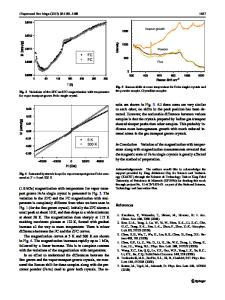Wet chemical synthesis and magnetic properties of single crystal Co nanochains with surface amorphous passivation Co lay
- PDF / 1,207,594 Bytes
- 5 Pages / 595.276 x 793.701 pts Page_size
- 32 Downloads / 319 Views
NANO EXPRESS
Open Access
Wet chemical synthesis and magnetic properties of single crystal Co nanochains with surface amorphous passivation Co layers Shao-Min Zhou*, Shi-Yun Lou, Yong-Qiang Wang, Xi-Liang Chen, Li-Sheng Liu and Hong-Lei Yuan
Abstract: In this study, for the first time, high-yield chain-like one-dimensional (1D) Co nanostructures without any impurity have been produced by means of a solution dispersion approach under permanent-magnet. Size, morphology, component, and structure of the as-made samples have been confirmed by several techniques, and nanochains (NCs) with diameter of approximately 60 nm consisting of single-crystalline Co and amorphous Co-capped layer (about 3 nm) have been materialized. The as-synthesized Co samples do not include any other adulterants. The high-quality NC growth mechanism is proposed to be driven by magnetostatic interaction because NC can be reorganized under a weak magnetic field. Room-temperature-enhanced coercivity of NCs was observed, which is considered to have potential applications in spin filtering, high density magnetic recording, and nanosensors. PACS: 61.46.Df; 75.50; 81.07.Vb; 81.07. Introduction In the last decade, diverse technological applications of magnetic nanostructures in magnetofluid, recording tape, flexible disk recording media, permanent magnets, microwave oscillators as well as biomedical materials, and catalysts have provided an impetus for extensive research in nanometer scale magnets [1-17]. Most of these applications rely on the stability of ferromagnetic ordering with temperature. In nanometer scale magnets, the thermal fluctuations randomize the magnetic moment by overcoming the anisotropy energy leading to unstable state of paramagnetism (non-magnetic materials) or superparamagnetism (corresponding coercivity and hysteresis fall to zero). Cobalt (Co) is superior to other ferromagnetic materials because of its highest Curie temperature (Tc) of about 1394 K, which is crucial for thermal stability in high-temperature nanodevice applications [1,5-16]. For realizing high Tc, magnetization, and coercivity, the aim must be directed toward increasing the amount of the ferromagnetic Co phase [7-10]. Owing to its basic metallic characteristic, pure cobalt, especially for nanosized Co, is very reactive and * Correspondence: [email protected] Key Lab for Special Functional Materials of Ministry of Education, Henan University, 475004 Kaifeng, People’s Republic of China
must be unstabilized in ambient air [11], and therefore, its use has been limited to prepare Co nanostructures in the absence of the shell [11-16]. A very simple bottomup method is to produce stable film-assisted synthesis for a surface with slightly controlled Co to passivate the surface of the host materials, including organic and inorganic templates, and alloyed technique [1,2,5-10,12-16]. For example, recently, control of magnetism in cobalt nanoparticles by oxygen passivation was reported by Srikala’s research group [14,15], and cobalt nanowires with controlled diameters have
Data Loading...











